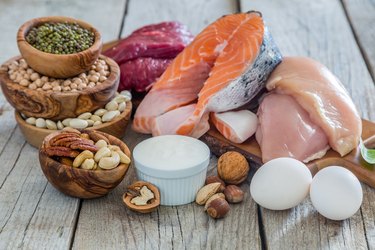
Take it from a health writer: You're definitely not the only person out there who's concerned about losing belly fat. And while belly fat can seem extra stubborn, just like all fat in the body, it will come off with some tweaks to your nutrition and exercise.
While you can't target fat loss in one area of your body, creating a calorie deficit, prioritizing healthier foods and building a balanced exercise routine are all measures that will bring you closer to the physique you want. Fat loss doesn't happen overnight, so above all, stay persistent in your efforts and patient with your body.
Video of the Day
Video of the Day
The Science Behind Belly Fat
Carrying a little extra fat around the abdomen is common with age, especially for people after they go through menopause, according to the Mayo Clinic. As you get older, it's normal for the metabolism to slow a bit, causing a decrease in muscle mass and increase in fat mass. Changing hormones also play a role in this process.
The extra fat you may see around your belly — the type you can pinch — is called subcutaneous fat and it makes up about 90 percent of your body fat, according to Harvard Health Publishing. But you may also be carrying visceral fat, which is located behind your abdominal wall and surrounds the organs.
Although visceral fat is generally not visible (but can begin to push against your abdominal wall over time, lending a "beer belly" look), it can pose some significant health risks, according to Harvard Health Publishing. Having higher levels of visceral fat has been connected with chronic health problems like heart disease, type 2 diabetes, high blood pressure and high cholesterol.

Tweak Your Nutrition to Burn Belly Fat
While visceral fat may sound scary (and it can be), you'll be happy to learn that it can be shed just like any other type body fat, according to the Mayo Clinic. Making some changes to your overall nutrition is the most important place to start.
1. Cut Your Calories
Creating a calorie deficit (when you burn more calories than you eat) is key to losing fat and involves first finding your caloric maintenance. This is the amount of calories you need to eat in order to maintain your current weight, according to the Mayo Clinic. This can be done by simply calculating your caloric intake for a few days and monitoring your weight.
Once you find how many calories you need to eat to maintain your current weight, you can safely cut between 500 to 1,000 calories each day, which should lead to between 1 and 2 pounds of weight loss each week, per the Mayo Clinic. Creating a sustainable deficit is the goal, though, so if cutting 1,000 or even 700 calories feels too difficult, for instance, try cutting 500 instead, or even a lower number that you can stick with.
Tip
Keep in mind that the amount of weight you lose by cutting 500 calories per day will vary greatly depending on the person. Weight loss will depend on factors like metabolism, genetics, level of physical activity, underlying health conditions and more.
2. Avoid Processed Foods
Eliminating the more processed, calorically dense foods from your diet will make it easier to create a calorie deficit. Look to avoid sugar-laden beverages or snacks, especially, as they can be high in calories but low in actual nutritional value, according to the Mayo Clinic.
Instead, prioritize nutrient-dense whole foods, including plenty of vegetables with each meal. Instead of refined carbohydrates (like white bread or pasta), focus on whole grains and starchy vegetables. Replacing red or processed meats with leaner proteins like chicken or fish will also cut back on calories.
3. Increase Your Protein
While you're cutting calories overall, you should actually up your daily protein intake to help your body burn fat and hang onto or build muscle mass. According to a December 2019 review in Advances in Nutrition, people who are actively losing weight should aim to eat 1.3 grams of protein per kilogram of body weight each day (rather than the 0.8 grams recommended for those maintaining their weight). Keep in mind that a kilogram is about 2.2 pounds. So, for example, a 150-pound person should aim for around 88 daily grams of protein.

Blast Fat and Build Muscle Through Key Exercises
While you can't magically turn belly fat into muscle, increasing your overall exercise can help increase your calorie expenditure, which will burn body fat. Plus, strengthening your core through exercises will help you develop a more muscular midsection.
Creating a balanced schedule of cardio and strength training will help promote body fat burn.
1. Make the Most of Cardio Workouts
When it comes to cardio exercise, you should aim to get at least 150 minutes of moderate-intensity cardio or 75 minutes of high-intensity cardio each week, according to the Physical Activity Guidelines for Americans.
High-intensity interval training (HIIT) cardio is a great way to maximize your calorie burn. HIIT involves alternating between intervals of high-intensity exercise and lower-intensity recovery. This style of training is great for revving your metabolism and can keep you burning calories several hours after your session is complete.
2. Hit All the Major Muscle Groups
Strength training is also crucial for a well-rounded, fat-burning workout routine. Your body composition (your ratio of fat to lean muscle mass) plays a role in the speed of your metabolism, according to the Mayo Clinic. The more muscle mass you have, the faster your metabolism burns calories.
A well-rounded strength-training regimen, paired with a healthy diet, will help increase your muscle mass, ultimately boosting your metabolism and calorie burn. You should aim to complete two or more strength-training sessions each week, including exercises for all the major muscle groups (back, arms, legs and core), according to the National Academy of Sports Medicine.
During your strength-training sessions, prioritize compound movements, as they burn more calories and exercise multiple muscle groups at the same time, according to the American Council on Exercise. Exercises like a reverse lunge and biceps curl or squat to shoulder press are great compound movements to incorporate each week.
All of these measures will help you shed fat and develop a leaner midsection, but patience will play a big role in achieving your goal. One to 2 pounds of weight loss per week may not seem like a lot, but it can make a huge difference for your overall health. So, even though you probably won't see a dramatic shift in your body just a week or two later, stay persistent with your nutrition and exercise to get where you want to be.
- Mayo Clinic: "Belly Fat in Women: Taking — and Keeping — It Off"
- Harvard Health Publishing: "Taking Aim at Belly Fat"
- Mayo Clinic: "Counting calories: Get Back to Weight-Loss Basics"
- Mayo Clinic: "Metabolism and Weight Loss: How You Burn Calories"
- National Academy of Sports Medicine: "Fitness. How Much Activity is Enough?"
- American Council on Exercise: "5 Benefits of Compound Exercises"
- Department of Health & Human Services: "Physical Activity Guidelines for Americans, 2nd Edition"
- Advances in Nutrition: "Protein Intake Greater than the RDA Differentially Influences Whole-Body Lean Mass Responses to Purposeful Catabolic and Anabolic Stressors: A Systematic Review and Meta-analysis"